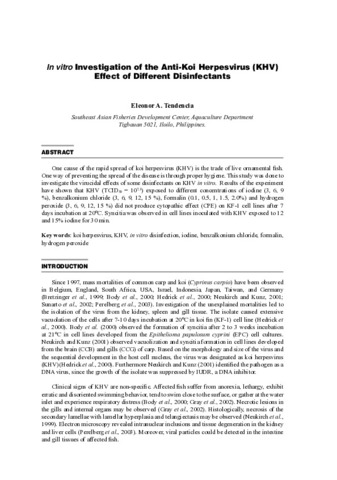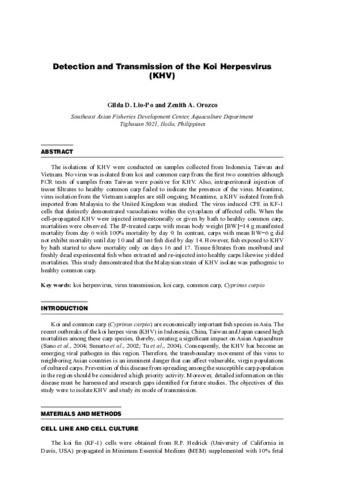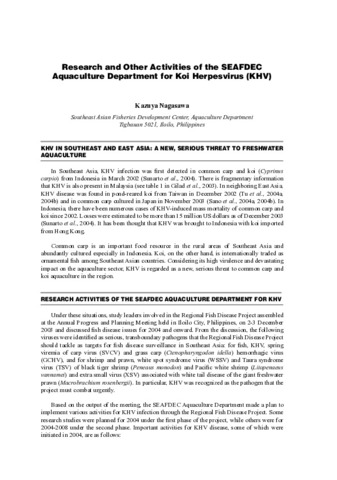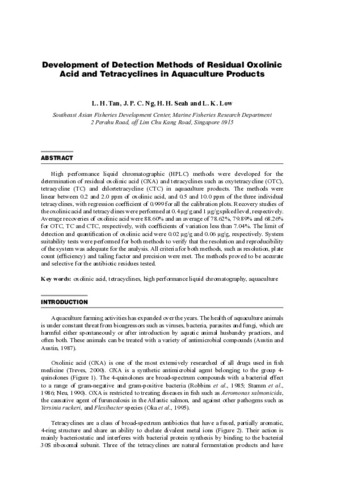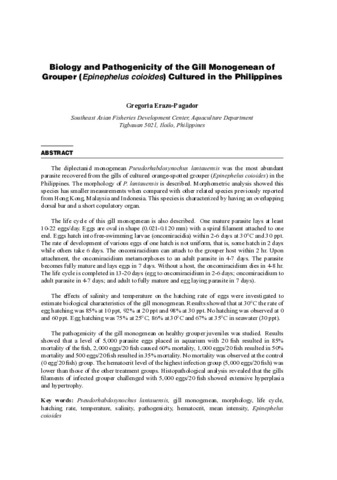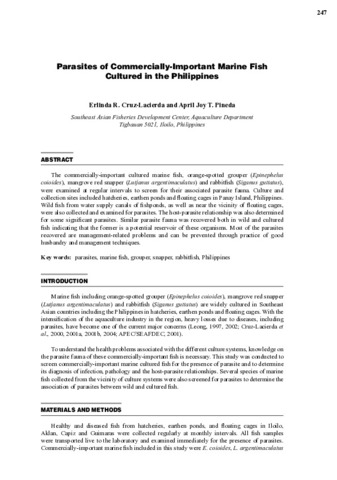SEAFDEC/AQD-Government of Japan-Trust Fund (GOJ-TF): Recent submissions
Now showing items 1-20 of 172
-
Recent advances in diagnosis and prevention of fish and shrimp diseases in Southeast Asia: Terminal report of the regional fish disease project on development of fish disease inspection methodologies for artificially-bred seeds funded by the Government of Japan Trust Fund from 2000 to 2004
(Aquaculture Department, Southeast Asian Fisheries Development Center, 2005-03)Fish diseases are one of the major constraints and threats to aquaculture production in Southeast Asia. Numerous infectious diseases have been reported from fish and shrimp cultured in this region. Currently, several ... -
Second SEAFDEC hands-on training for important viral diseases of shrimp and marine fish
(Aquaculture Department, Southeast Asian Fisheries Development Center, 2005-03)The Second SEAFDEC Hands-on Training for Important Viral Diseases of Shrimp and Marine Fish was conducted at the SEAFDEC Aquaculture Department in Iloilo, Philippines on 5-21 November 2003. The objective of the training ... -
First SEAFDEC hands-on training for important viral diseases of shrimp and marine fish
(Aquaculture Department, Southeast Asian Fisheries Development Center, 2005-03)The issue on aquatic animal diseases, particularly viral diseases, in shrimp and fish is a priority because of the risks involved with the spread of diseases in aquaculture in Southeast Asia. To support existing activities ... -
In vitro investigation of the anti-koi herpesvirus (KHV) effect of different disinfectants
(Aquaculture Department, Southeast Asian Fisheries Development Center, 2005-03)One cause of the rapid spread of koi herpesvirus (KHV) is the trade of live ornamental fish. One way of preventing the spread of the disease is through proper hygiene. This study was done to investigate the virucidal effects ... -
Hematology of koi (Cyprinus carpio) infected with koi herpesvirus (KHV)
(Aquaculture Department, Southeast Asian Fisheries Development Center, 2005-03)Koi (Cyprinus carpio, mean body weight=10 g) was experimentally infected with koi herpesvirus (KHV) by intraperitoneal injection with undiluted supernatants from KF-1 cell cultures showing cythopathic effect (CPE) 7 days ... -
Histopathology of koi herpesvirus (KHV) disease
(Aquaculture Department, Southeast Asian Fisheries Development Center, 2005-03)Common carp (Cyprinus carpio) fingerlings (total length=59-165 mm; body weight=32-63 g) were sampled in April 2004 from koi herpesvirus (KHV)-infected farms in Cirata, West Java, Indonesia for histopathological studies. ... -
Standardization of PCR techniques as the detection method for koi herpesvirus (KHV) infection in koi and common carp
(Aquaculture Department, Southeast Asian Fisheries Development Center, 2005-03)Several runs have been made using the two published PCR protocols in the detection of koi herpesvirus (KHV). The primer pairs designed by individual authors based from the sequence of a cloned fragment of KHV genome ... -
Detection and transmission of the koi herpesvirus (KHV)
(Aquaculture Department, Southeast Asian Fisheries Development Center, 2005-03)The isolations of KHV were conducted on samples collected from Indonesia, Taiwan and Vietnam. No virus was isolated from koi and common carp from the first two countries although PCR tests of samples from Taiwan were ... -
Research and other activities of the SEAFDEC Aquaculture Department for koi herpesvirus (KHV)
(Aquaculture Department, Southeast Asian Fisheries Development Center, 2005-03) -
Monitoring of antimicrobial usage and drug resistant bacteria in shrimp (Penaeus monodon) culture in Thailand
(Aquaculture Department, Southeast Asian Fisheries Development Center, 2005-03)The susceptibility and resistance of Vibrio from shrimp were tested using chemotherapeutants that has been widely used in the past and at present in Thailand. Minimal inhibitory concentration (MIC) of oxolinic acid (OA), ... -
Development of detection methods of residual oxolinic acid and tetracyclines in aquaculture products
(Aquaculture Department, Southeast Asian Fisheries Development Center, 2005-03)High performance liquid chromatographic (HPLC) methods were developed for the determination of residual oxolinic acid (OXA) and tetracyclines such as oxytetracycline (OTC), tetracycline (TC) and chlortetracycline (CTC) in ... -
Detection of pesticide residues in Philippine aquaculture products
(Aquaculture Department, Southeast Asian Fisheries Development Center, 2005-03)Detection and monitoring of pesticide residues in aquaculture-derived products are important considerations for the safety and health of consumers. A study was conducted with the aim of developing, standardizing and ... -
Establishment and application of prevention and control methods against parasites of fish cultured in the Philippines
(Aquaculture Department, Southeast Asian Fisheries Development Center, 2005-03)The efficacy of bath treatment methods against the ectoparasites Amyloodinium ocellatum, Pseudorhabdosynochus lantauensis and Zeylanicobdella arugamensis on marine fish was determined under laboratory conditions. The ... -
Leech infection in grouper (Epinephelus coioides) in the Philippines
(Aquaculture Department, Southeast Asian Fisheries Development Center, 2005-03)The effect of infection with the leech Zeylanicobdella arugamensis on the hematological parameters in orange-spotted grouper (Epinephelus coioides) was determined. The hematocrit, hemoglobin and total plasma protein of ... -
Biology and pathogenicity of the gill monogenean of grouper (Epinephelus coioides) cultured in the Philippines
(Aquaculture Department, Southeast Asian Fisheries Development Center, 2005-03)The diplectanid monogenean Pseudorhabdosynochus lantauensis was the most abundant parasite recovered from the gills of cultured orange-spotted grouper (Epinephelus coioides) in the Philippines. The morphology of P. lantauensis ... -
Important parasites of freshwater fish in Thailand and neighboring countries
(Aquaculture Department, Southeast Asian Fisheries Development Center, 2005-03)Snakehead fish (Chana striata) from Thailand and Cambodia were sampled for parasitological study. The project was carried out from August 2003 to January 2004 twice a month. The results showed that there were 22 genera ... -
Important parasites of catfish (Clarias macrocephalus) in the Philippines
(Aquaculture Department, Southeast Asian Fisheries Development Center, 2005-03)The parasite fauna of broad head catfish (Clarias macrocephalus) was determined through regular examination of cultured and wild-caught fish. Collection areas included hatchery, nursery and grow-out facilities in Iloilo ... -
Parasites of grouper (Epinephelus coioides) cultured in Thailand
(Aquaculture Department, Southeast Asian Fisheries Development Center, 2005-03)Orange-spotted grouper (Epinephelus coioides) cultured in Thailand were examined for their parasites. There were five parasitic groups found in this investigation, viz., protozoans (four genera), monogeneans (five genera), ... -
Parasites of commercially-important marine fish cultured in the Philippines
(Aquaculture Department, Southeast Asian Fisheries Development Center, 2005-03)The commercially-important cultured marine fish, orange-spotted grouper (Epinephelus coioides), mangrove red snapper (Lutjanus argentimaculatus) and rabbitfish (Siganus guttatus), were examined at regular intervals to ... -
Development of immunological indices for monitoring health status in shrimp (Penaeus monodon)
(Aquaculture Department, Southeast Asian Fisheries Development Center, 2005-03)Some hemolymph parameters were determined as non-invasive early-warning indicators of health status in black tiger shrimp (Penaeus monodon). These included total hemocyte count (THC), respiratory burst activity, phenoloxidase ...




